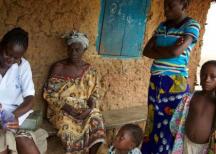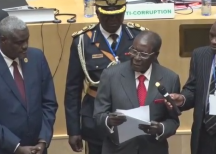Senegal was one of the first African countries to engage in privatisation of key sectors of its economy. Although Ghana now provides a “model” for international financial institutions, in particular the World Bank, Senegal soon found a place among those “pupils” instanced as examples of privatisation, writes Hawa Ba. The economic process set in motion at the end of the 70s had as its natural corollary the retreat of the State from the guardianship of key economic sectors and the selling off of national corporations.
From the programme of economic and financial recovery launched at the departure of former President Senghor to the structural adjustment plans initiated in the mid 80s under the Abdou Diouf regime, to poverty-reduction strategies, a variety of phenomena accompanied the deconstruction of the social and economic sector. The supposed solutions across different policies put in place by international financial institutions have never generated the growth expected as a driver of development. Worse, the “less State” from which “better State” was expected to follow, simply created a vacuum tending to nullify all public services and social policy.
It was the cult of the private sector above everything. Not even the most strategic state enterprises were able to resist this logic. This is the case of Senegal’s national water company (SONEES). Thus, the symbolic image of water as a universal resource belonging to everyone but not to any one private individual, carried no weight against the hunger for privatisation. Privatisation, it was said, would be the solution to the well-known dysfunctionality of the sector which was unable to meet populations’ growing needs. But instead of addressing the many well-reported barriers to access to water and electricity, these privatisations only served to render more precarious the position of the most disadvantaged in society. Access to water and to electricity has become more chancy, exacerbated by exorbitant rising costs.
Seen as the repository of all evils, public services and the notion of public good were supplanted by the cult of profit, assets and productivity. The most elementary rights of citizens, including the right to natural resources and to have a say in their form of management were flouted. Negotiations and decisions were made over their heads, so much so that that one can speak of the diktatof the World Bank and the International Monetary Fund imposed on States and political leaders who have no control over their destiny.
Established as a slogan during the 1980s, “a smaller state equals a better state” had practically become an incantation in the mouths of rulers. A formula on everyone’s lips, it appeared all the more scandalous in being a deliberate denial of the pauperisation and misery in which these policies plunged the most disadvantaged social strata. It was like an inevitable process, an ineluctable logic. Between “liberalisation” and “privatisation” fetishised language littered the discourse of decision-makers while at the same time creating a living death for whole populations.
In Senegal, as in almost all the other poor countries forced to undergo this “treatment”, the international financial institutions in the form of the World Bank and the International Monetary Fund had a ready-made mechanism: the quasi systematic conditionality attached to the awarding of loans. These required first the restructuring of the public sector and national corporations and then the privatisation of state holdings. As a result of this restructuring , thousands of workers found themselves on the streets. To reduce the overall salary total, unemployment was encouraged. To make enterprises more saleable it was necessary to reduce the size of their workforce. To absorb the fiscal deficits arising from these enterprises there was no hesitation in passing on their profit and loss accounts. At the same time, the State abrogated its role as provider and turned its back on its social responsibilities. Crucial sectors such as education and health were starved of subsidy, following the received economic-political wisdom which encouraged the State to invest as little as possible.
In what follows, we will consider further the issue of water privatisation and its socio-economic implications for Senegal.
In 1995, in accordance with the instructions of the World Bank, Senegal undertook privatisation of its water sector. As a result, the national water company (la Société Nationale d’Exploitation des Eaux du Sénégal (SONEES)) was divided into two organisations: the Senegalese national water company (Société Nationale des Eaux du Senegal (SONES)), the holding company, and the Sénégalaise des Eaux (SDE), the operating company, a private enterprise. The purchaser was SAUR, a subsidiary of the French Bouygues Group. SAUR retains a 51% share, the remaining 49% being divided between the Senegalese state (5%), private Senegalese individuals (39%) and the employees of the defunct SONEES (5%). SONES is responsible for the management of national water resources and all State holdings pertaining to this sector, while SDE retains the exclusive monopoly for commercial exploitation. Under this arrangement, the latter makes the profits and must pay dues to SONES.
The most ludicrous aspect of this affair is that the contract between SDE and SONES and, by extension, the Senegalese State, only relates to commercial exploitation of urban water resources. This demonstrates how far considerations of financial profitability were a priority. The billing and collecting of water rates were considered more likely to be effective in an urban environment where users would be more financially solvent, but also where the means of coercion would be more effective in case of non-payment of bills. It was thus “logical” for urban centres to benefit from the majority of SONES investments to improve infrastructure and guarantee a good system for recovery of rates. So, although consumers living in urban centres benefited to a certain extent from better services (modernisation of infrastructure, improvement in water quality), those living in rural areas were left out in the cold. At the level of the overall operation of the State this gave rise to serious implications: it created a dichotomy in the allocation of services across the national population which was based on financial advantages to multinational companies.
It is important to recall that SAUR is fundamentally a capitalist enterprise – a multinational which has spread its tentacles throughout the world and which is motivated only by profit. Whether in Senegal or in any other country in which it has bought out the water sector, its relationship to this resource is the same as it would have had with any other commercial product. The worst of it all is that our States are irresponsible and that they have no consideration for the cultural and social relationships that their populations have to the utilities that they are manipulating.
How else can one understand their decision from one day to the next to transfer the operation of a utility which, since time immemorial, has been considered a public good in the popular imagination, and around which many societal processes cohere, handing it over to operatives unfamiliar with the social context, without even considering it necessary to draw up a code of conduct taking account of local conditions?
Both in the villages and in the poorest areas of the towns, a widespread quasi-institutional practice had been established of erecting fountains where local populations without domestic water supply could receive free water. To rationalise usage and avoid wastage, local community leaders or others in whom local populations had confidence were given the responsibility of managing these water supplies. Timetables were agreed with neighbourhoods to enable local people to build up their reserves, usually early in the morning and late in the afternoon. In addition, special treatment could be given to such institutions as schools and Koranic teaching institutes, mosques and other such bodies so that they would receive water either free or at special rates.
Privatisation did away with all such allowances. It became necessary to spend money to drink! Similarly for water for food preparation, making one’s toilet and doing housework. Tariffs were established and water had to be bought by the basin or the bucket in the case of local fountains. Prices varied according to location. Moreover, neighbourhood fountains were condemned to disuse, the aim being to oblige each home to have a connection to SDE with a corresponding billing system. Those bodies which had benefited previously from preferential treatment were required to subscribe through a billing system under which they paid bi-monthly bills in the same way as other users.
For many people, this new regime resulted in a penny-pinching use of a utility which had suddenly become scarce; or in recourse to alternative sources of water such as rivers. This water, which was not intended for drinking, gave rise to public health problems in poor homes where it was used in food preparation. It is not too much to suggest a causal link between limited access to water and the proliferation in recent years of diseases such as cholera in Senegal. Known also as the “dirty hands disease” precisely because it is due to a lack of cleanliness, cholera epidemics continue to break out in a variety of locations. Experience has shown that this happens almost exclusively within populations which only have very limited or no access to drinking water.
Furthermore, it is quite usual to encounter educational establishments whose water has been cut off due to their inability to pay their bills. In such cases, students fall back on local houses during their breaks to request a glass of water or to use the toilet. In this way, an unexpected vulnerability has opened up in this sector. The collateral risks of such measures are real ones. Children are exposed to a variety of dangers, including being given non-drinking water or, for little girls, the risk of sexual abuse.
Moreover, many other social benefits linked to the use of neighbourhood fountains are denied to women for whom this represents an essential aspect of their social lives. Being able to gather every morning and afternoon at the fountain enables them to meet friends, to discuss recent happenings in their lives, and, in short, to escape briefly from the daily grind. The “commodification” of water favours an entirely different relationship with water and with the act of fetching it.
The proponents of privatisation pride themselves on bringing out its positive aspects, such as infrastructure modernisation, distribution of better drinking water or further reduction of wastage at the fountains. For example, in relation to access to water, Ndaw believes that ‘ the balance sheet for the programme after 8 years [ie from 1995 to 2003] shows that it fits perfectly with the implementation strategy for the Millenium Development Objectives for urban areas. In fact, figures for coverage of the Dakar region show that the proportion of the population served increased from 80.3% in 1995 to 96% in 2004 (76% by means of domestic connection and 20% by means of local fountains), ie 620,000 additional service users. For other urban centres (amounting to 1,9 million individuals) the level of reasonable access to water in 2004 is 84% (57% through domestic connection, 18% through local fountains and 9% through modern wells), ie 400,000 additional service users’.
These arguments have been seriously called in question by numerous studies showing that the privatisation of the water sector has not given rise to a significant number of additional domestic connections. Aide Transparence’s inquiry disagrees, as it reveals that ‘the number of connections in the perimeter has increased from 203,902 in 1996 to 26,4161 in 2002, ie an increase of 60,259 over 6 years. For a population of 10,000,000 inhabitants, this does not seem to represent a significant achievement. (…) The level of service in the perimeter rose from 72.5 in 1996 to 83.1 in 2001, although it was supposed to reach 95% according to the contract between the State, SDE and SONES’.
Nor has privatisation solved the problem of water quality. The Aide Transparance report shows that consumers often complain about a reduction in water quality and, from time-to-time consumers’ organisations campaign for improved services. It is undeniable that consumers do not have confidence in the quality of the water that comes from the taps. Indeed, the use of mineral water has never before been so widespread in Senegal. Anyone who can afford this luxury now prefers to use bottled water – to such an extent that the sale of mineral water has become a very profitable sector. In the space of two to three years, at least three new companies producing mineral water have been set up and are showing an impressively healthy balance sheet. Originally seen as a privilege reserved for the comfortably off who used it to signal their material wealth, mineral water consumption is now seen as a means of avoiding a health risk.
Long periods during which water supplies are cut off in certain areas or at certain points in the year are legion. It can happen that in these areas, there is no tap water for a whole day or even for several days. A frequent scene is of large groups of women, basins in hand, wandering from one area to another in search of water for drinking and for preparing family meals. Observation has shown that the hottest period in the year is the worst in terms of water supply. It has also been demonstrated that the water supply infrastructure is not capable of meeting consumers’ needs because, as soon as there is a significant concentration of population in a given location, the SDE cannot satisfy the increase in demand. Such is the case during religious festivals which bring together large groups of the population for a specific period. This has resulted in real anguish among local communities and “pilgrims” in the run-up to religious celebrations.
All this goes to show that even the promised technical improvements have not lived up to their promise.
A further crucial is that of the cost of water. There is not a shadow of doubt that the privatisation of water has brought with it an increase in prices. The Aide Transparence inquiry tells us that this increase was around 40% in 2003. This is exorbitant! The following passage shows how, in a subtle fashion, SDE considerably increased the costs for each of the tariff packages. ‘Analysis of the different tariff packages offered between 1995 and 2003 shows that the SDE’s tariffs for social consumption (i.e consumption of between 0 and 20 m3) grew from156.7FCFA in 1995 to 191.32FCFA on 1 January 2003. At the same time the full tariff grew from 534.48 in 1995 to 629.88 for consumption of between 20 and 41 m3, and from 534.48 to 629.88 for consumption of between 41 and 100m3, on 1 January. Combining all these increases shows an average hike of nearly 40% on the price of water between 1995 and 2003’.
From whatever angle one considers water privatisation in Senegal, one constant remains: the priority given to the profit and loss aspects of the business. The process of privatisation has resulted in the right of access to water for each individual and concern for social justice in giving each member of society the same chance to make use of State-provided services, being relegated to a lower level of priority. The poor are the rejects of the different policies instigated by international financial institutions and applied by those who govern us, who have no remedy for the suffering of increasing numbers on the margins of society.
Hawa Ba works for Fahamu and is Pambazuka News West Africa Regional Correspondent.
This article was first published in the French edition of Pambazuka News, no 7:
* Please send comments to [email protected] or comment online at www.pambazuka.org



































